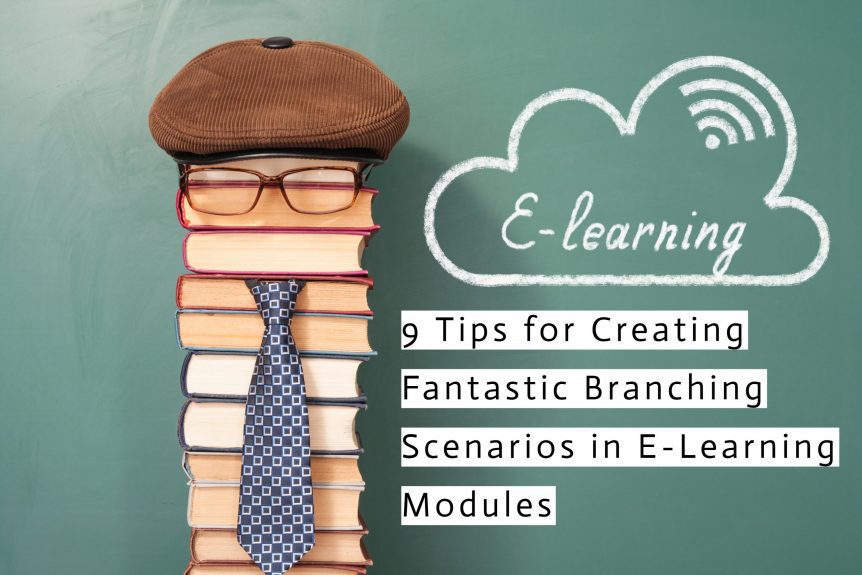9 Tips for Creating Fantastic Branching Scenarios in E-Learning Modules
Making employee training engaging is crucial to achieving your training objectives. Engaging training courses enhance learner satisfaction levels and improve results. This could be anything from changing behaviour to developing skills to improving standards. One way to make your e-learning courses engaging is to include branching scenarios.
You must make sure you get branching scenarios right, though, as a poor-quality attempt will detract from the learner experience rather than enhancing it.
Before looking at the tips for creating fantastic branching scenarios, let’s first define what they are.
What Is a Branching Scenario?
A scenario in e-learning is similar to role-playing situations you may have used in classroom-based training. In other words, you create a scenario – a virtual situation – and ask the learner to use their new skills or knowledge to deal with it, i.e. make a decision, interact with someone, make an assessment, etc.
A branching scenario takes this a stage further as it is multi-level. So, the response a learner gives to one section leads to something different.
There are two main types of branching scenario:
- A simple branching scenario where there are different paths based on the learner’s role in the organisation.
- Complex branching scenario with multiple paths based on decisions the learner makes, i.e. where each decision, assessment, or response has an outcome that presents a new set of circumstances for the learner to deal with.
As well as being engaging, branching scenarios also create a safe place for learners where they can deal with challenging situations, make mistakes, and develop their skills.
Creating Effective Branching Scenarios
1. Ensure You Fully Understand Your Audience
Understanding your audience is crucial to the following point, so this should be your first step. You need to understand a range of factors including their current abilities and day-to-day experiences.
2. Make the Scenario Realistic and Relevant
Learners will not respond well to scenarios that have no relevance, or which the learner regards as unrealistic. They won’t see the point of the scenario if it doesn’t represent real life.
Therefore, it is essential to make your scenarios realistic and relevant.
3. Clearly Explain to Learners How the Scenario Will Help the Learning Experience
As with other aspects of training and e-learning, it also helps to explain why the course, section, or module is important, as well as what the learner can expect. For example, explain that you have designed the branching scenario to equip them with the tools they need to deal with such situations in real life.
4. Take an Approach Where Every Answer, Right or Wrong, Is a Learning Opportunity
Scenarios are not the same as a quiz, as quizzes often play a role in assessing progress. Instead, scenarios are a learning tool.
After all, it is better that learners make mistakes working through a branching scenario than in a real-life situation. The mistakes they make in an e-learning course don’t impact on the operation of your business, so your team can learn from them.
For example, they can learn how a decision, course of action, or approach impacts the outcome of particular situations, positively or negatively.
5. Identify the Possible Outcomes for Each Decision
The practicalities of creating branching scenarios include creating outcomes. In other words, the outcome of a decision or course of action the learner chooses to take. Therefore, you will need to identify those possible outcomes.
For each decision, try to identify the best and worst outcomes, as well as those in between.
6. Ensure Outcomes Are Accurate and Plausible
It is best to avoid guessing when it comes to developing outcomes as they must be both plausible to the learner and accurate. You will lose their attention and interest if they are not.
If you are unsure, this is a time to talk to subject matter experts on the course you are developing to ensure your outcomes are accurate.
7. Map Out the Various Branches
Another practical tip for developing a branching scenario is to map out the various branches, plotting in the outcomes along the way. This is particularly important for complex branching scenarios to ensure learners don’t end up in a loop or a dead end.
8. Ensure the Design is High-Quality
Branching scenarios are an advanced e-learning feature, so they can be challenging to develop to a high standard. However, your learners will expect high standards so this should be your goal.
The best approach is usually to hire a professional e-learning developer in Saudi Arabia or the UAE as they will have experience creating effective branching scenario elements for e-learning courses.
This will require an investment, but you will benefit through improved results.
9. Test
The final tip is to test your branching scenario and then test again. Go through all the various options that you can to ensure everything works as expected. You also need to make sure the outcomes are as described above – realistic, accurate, and plausible – and that learners will reach a conclusion or endpoint whatever route they take.
Getting Results
Adding a branching scenario to the next e-learning course you develop will not guarantee excellent results. You need to follow the above nine best practice tips, of course, but there are other factors involved in ensuring your course is as good as possible.
Branching scenarios will move the course to another level, however, and can significantly contribute to its success. They are definitely worth considering.
